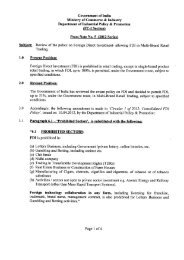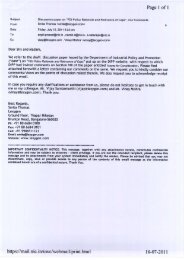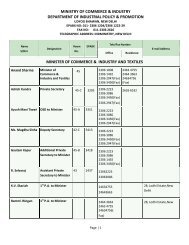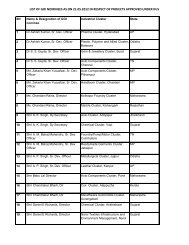fdi in india and its growth linkages - Department Of Industrial Policy ...
fdi in india and its growth linkages - Department Of Industrial Policy ...
fdi in india and its growth linkages - Department Of Industrial Policy ...
You also want an ePaper? Increase the reach of your titles
YUMPU automatically turns print PDFs into web optimized ePapers that Google loves.
FDI IN INDIA AND ITS GROWTH LINKAGES<br />
picked up <strong>and</strong> surged from $4 billion <strong>in</strong> 2005 to $11 billion <strong>in</strong> 2006. In terms of SDR volume, a similar trend <strong>in</strong> FDI<br />
<strong>in</strong>flows can be observed.<br />
Table 8.2 shows the distribution of FDI by DIPP sectors. It may be observed from the table that dur<strong>in</strong>g January 2000<br />
– June 2007, the service sector accounted for the highest amount of FDI <strong>in</strong>flows (21.6 per cent), followed by electrical<br />
equipment (19.8 per cent) <strong>and</strong> miscellaneous <strong>in</strong>dustries (15.4 per cent). With<strong>in</strong> the service sector, f<strong>in</strong>ancial <strong>and</strong> other<br />
services attracted about 10.3 per cent <strong>and</strong> 5.5 per cent, respectively, while bank<strong>in</strong>g services attracted about 2 per cent of<br />
FDI. With<strong>in</strong> the electrical equipment sector, the computer software <strong>in</strong>dustry attracted the highest share at 15.8 per cent,<br />
followed by electrical equipment with 2.4 per cent. Miscellaneous <strong>in</strong>dustries comprise major activities like construction,<br />
real estate, diamonds, ornaments <strong>and</strong> gold, agriculture (hybrid seeds <strong>and</strong> plantation), floriculture, tea/coffee <strong>and</strong> pr<strong>in</strong>t<strong>in</strong>g<br />
of books. Among these groups, construction <strong>and</strong> real estate received about 4.9 per cent <strong>and</strong> 2.9 per cent, respectively.<br />
Further, telecommunications received about 9.8 per cent of cumulative FDI.<br />
The FDI <strong>in</strong>flows by country of orig<strong>in</strong> are presented <strong>in</strong> Table 8.3. FDI <strong>in</strong>flows from various <strong>in</strong>vest<strong>in</strong>g countries, by <strong>and</strong><br />
large, showed an <strong>in</strong>creas<strong>in</strong>g trend. Among the countries, Mauritius emerged as the top country through which 44.9 per<br />
cent of the total FDI reached India. The bilateral agreements, <strong>in</strong>clud<strong>in</strong>g the Double Taxation Avoidance Act between<br />
India <strong>and</strong> Mauritius, favoured companies located <strong>in</strong> Mauritius that <strong>in</strong>vested <strong>in</strong> India. The US <strong>and</strong> the UK accounted for<br />
about 9.7 per cent <strong>and</strong> 8.6 per cent of total FDI <strong>in</strong>flows, respectively. Japan, one of the highest contributors of official<br />
development assistance <strong>in</strong> India, accounted for about 4.6 per cent of total FDI.<br />
The country-wise FDI <strong>in</strong>flows <strong>in</strong> DIPP 4-digit sub-sectors of the aggregate 92 sectors provides more detailed sectoral<br />
<strong>in</strong>formation about FDI <strong>in</strong>flows (Table 8.4). Among the top <strong>in</strong>vest<strong>in</strong>g countries, the maximum FDI from Mauritius <strong>and</strong><br />
the United States appears <strong>in</strong> the sub-categories of computer software <strong>in</strong>dustry <strong>and</strong> f<strong>in</strong>ancial services. Inflows from the<br />
UK are concentrated <strong>in</strong> the sub-category “other services”. The Netherl<strong>and</strong>s has <strong>in</strong>vested <strong>in</strong> the computer software<br />
<strong>in</strong>dustry, “other miscellaneous <strong>in</strong>dustries” <strong>and</strong> “other services”. Investments from Japan are concentrated <strong>in</strong> the subcategories<br />
of electrical equipment <strong>and</strong> the automobile <strong>in</strong>dustry, <strong>in</strong>clud<strong>in</strong>g passenger cars. S<strong>in</strong>gapore has <strong>in</strong>vested <strong>in</strong><br />
f<strong>in</strong>ancial services, “other miscellaneous <strong>in</strong>dustries” <strong>and</strong> “other services”. Inflows from Germany are concentrated <strong>in</strong> “other<br />
miscellaneous <strong>in</strong>dustries”, chemicals <strong>and</strong> <strong>in</strong>surance.<br />
8.10 Concordance between DIPP <strong>and</strong> National <strong>Industrial</strong> Classification (NIC), 2008<br />
As discussed elsewhere, the sectoral classification of FDI should reflect all economic activities tak<strong>in</strong>g place <strong>in</strong> the<br />
economic territory of India. India’s NIC 2008 is based on the International St<strong>and</strong>ard <strong>Industrial</strong> Classification (ISIC)<br />
Revision 4, which is widely used by countries to compile FDI statistics. Details of the DIPP classification are provided<br />
<strong>in</strong> Table 8.5. Here, we have attempted to construct a concordance table between DIPP 92 4-digit sectors <strong>and</strong> the NIC-<br />
2008 classification at 2 <strong>and</strong> 3 dig<strong>its</strong>; NIC-2008 has 99 sectors at the 2-digit level <strong>and</strong> 238 sectors at the 3-digit level.<br />
The concordance schemes are provided <strong>in</strong> Table 8.6 <strong>and</strong> Table 8.7, respectively. We have created an additional 93rd<br />
DIPP sector (4300) that conta<strong>in</strong>s all the NIC sectors which could not be covered under any of the 92 DIPP 4-digit<br />
sectors. Thus, our mapp<strong>in</strong>g concordance is comprehensive <strong>and</strong> <strong>in</strong>cludes all the 2-digit <strong>and</strong> 3-digit NIC-2008 sectors.<br />
8.11 Recommendation<br />
To conclude, DIPP follows the modified sectoral classification furnished <strong>in</strong> the Industries Development <strong>and</strong> Regulation<br />
Act, 1951 to present FDI data by sector. However, this classification is <strong>in</strong>adequate as it is based on a high level of<br />
aggregation of economic activities. The widely followed st<strong>and</strong>ard classification is the National <strong>Industrial</strong> Classification.<br />
Therefore, NCAER recommends that DIPP base <strong>its</strong> FDI statistics classification on NIC-2008.<br />
96












